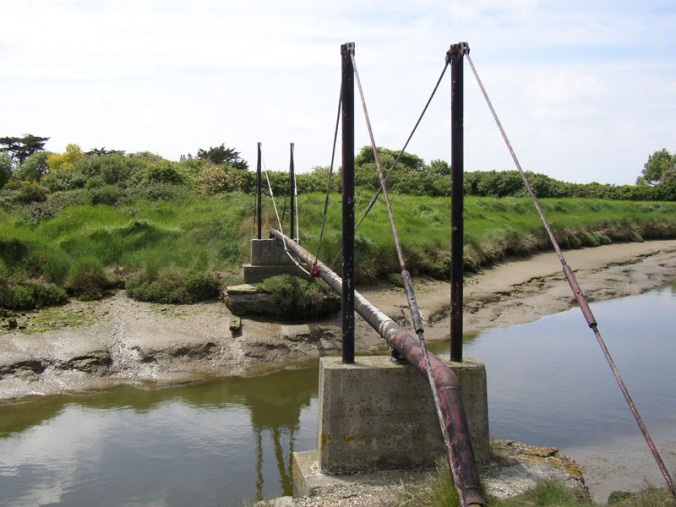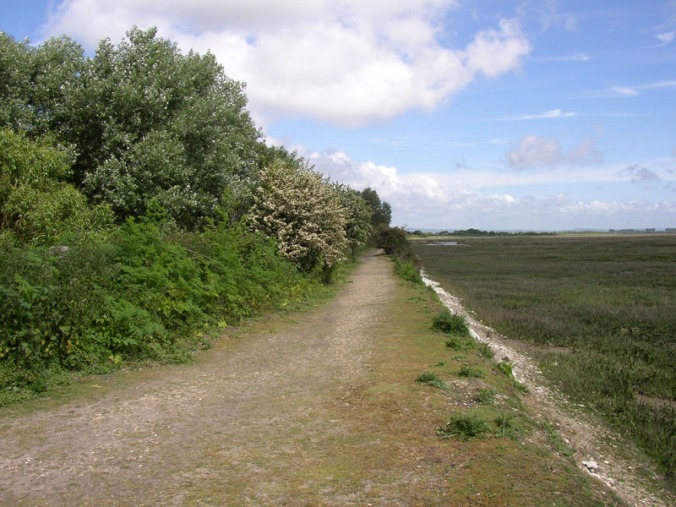Walk 15
Monday May 31st 2004
Selsey to Pagham
West Sussex
Today was bank holiday Monday so the trains were running a Saturday service and the buses a Sunday one and after much studying of timetables it was decided that a walk would be possible. Glyn kindly drove us into Guildford for the 7.42 fast train to Havant where we caught another to Chichester then a bus to Selsey.
The main road into Selsey is dead straight appearing to screech to a halt just above the waves pounding on the rocks below. The bus terminus is a few yards inland outside the Selsey Bill pub and we were very soon under way.
We began by walking through a car park and along an easy path on the edge of the sea all the way to the famous Selsey Bill itself. It is impossible to stand on the point as there are several very large and exclusive but also very precarious houses here. They must take the brunt of the winter storms but at the same time command the most beautiful views out to sea. A short diversion behind the houses brought us out on the coast facing east having turned the corner of the southernmost point of Sussex.
There was a good concrete path on top of a sea wall here which meant we made good progress north eastwards. After half an hour or so, we stopped for a breather on a bench in front of a fabulous children’s playground and chatted to a lady with a dog called Max.

OLYMPUS DIGITAL CAMERA
The lady filled us in with some local history especially about a housing estate immediately behind us of new, very suburban houses, which seemed to pay no attention to the local building styles. They had been built on the site of a Warners Holiday camp, which had, in turn, been built in the site of an asparagus farm. She cheerfully predicted that they would not be there in ten years time and warned us never to buy a house on the seafront here, but to live one road behind. We agreed that this was very sound advice and all went on our way happy with a little inside information given and received.
Soon we neared Selsey Lifeboat station with its publicity stand and gift shop, neither of which were open. The loos were, thankfully, and we stopped to use them.
While Jen was inside I watched the coastguard pursuing a small boat which stopped far too quickly for it to be really exciting
We continued along the path until it ran out, forcing us onto shingle as we entered Pagham Harbour Nature Reserve. Today’s walk really embodied three types of walking we dislike – around harbours, through nature reserves and on shingle, so the day was not looking good even before it had really started!
However we soon found a softer path and then turned left over some rather dodgy railway sleepers to begin walking around Pagham harbour itself. The surface became easier and we actually met a man with a pushchair and then lots more people so we deduced we were approaching a car park.
We had reached Church Norton where we were tempted to stop and look at the chapel. However it would have been quite a detour so, after a brief biscuit stop, pushed on. Church Norton was the original 7th century seat of St Wilfrid, the Bishop of the South Saxons and the man credited with bringing Christianity to pagan Sussex. For around three centuries, therefore, Church Norton was the hub of Christian decision making in Sussex. Once the Normans arrived and built a cathedral in nearby Chichester, Church Norton slowly dwindled in importance and became the quiet village it is today.
We struggled along a quite soggy foreshore before realising that we should have been on an embankment path above. We found a way onto the path and the walking became much easier and a lot drier. In many parts of Pagham Harbour it is not obvious where the solid land ends and the harbour begins and it is very easy to head off in the wrong direction.
From the top we had a good view over the harbour and inland and also caught a welcome pleasant breeze as the day was heating up. The embankment path seemed to go on for ever but was good and although overgrown and narrow there were no nettles. Towards the end of the path we enjoyed watching a mother moorhen with a very new baby, feeding and diving. The path ended at the road into Selsey, so we must have seen this point from the bus had not realised where it was.
We crossed the creek at the end of the harbour and found a bench on the other side. This was an interesting spot for several reasons. The creek is called Ferry Creek and the map revealed that there is a Ferry House and Ferry Farm nearby. There is no sign of a ferry now and we were intrigued as to where it had once been and where it used to travel to. (Later research discovered that Selsey used to be an island and the ferry crossed here from the island to the mainland.) This was also the place where the Selsey Tram railway crossed the water and there were obvious signs of a track bed and crossing place.

Just leaving the bench were three men whom we chatted to for a bit. One was in a wheelchair and they apparently travel out and about a lot. They were heading back to their car and then into Selsey so we showed them a seaside car park that was not marked on their map. We then decided this was as good a place as any to stop for lunch and took their place on the bench.

After lunch we set off along the track bed of the tramway which was lovely underfoot. Unfortunately Jen spooked me by talking about ghost trains! Luckily it was bright sunny day. We found a little information about the tramway from a signboard and found it so fascinating that we later bought the book. The tram ran from Chichester to Selsey between 1897 and 1935 and was, by all accounts, a totally ramshackle affair which only kept going by several miracles. The fact that there were never any fatalities on the line was mainly due to the fact that the journey was undertaken at little more than walking pace. Even so it was invaluable to the local communities as an alternative route into Chichester. It was also known as the Sidlesham Snail (Sidlesham being one of the station en route) and one verse of a song written about it ran
“The Siddlesham snail,
The Siddlesham snail,
The boilers burst,
She’s off the rail,
The Siddlesham snail!”
To our surprise, at the end of the trackbed section we encountered the same three men once again sitting on a bench. This time a different one was in the wheelchair. I felt echoes of “Last of the Summer Wine” about them.
Soon after leaving them for the second time we came to Mill Lane at Sidlesham – the top of the harbour and the site of an ancient tide mill.
There was nothing left to show that there had ever been any sort of activity there at all. However there was a very welcome pub called The Crab and Lobster and we stopped there for a drink and visit to the loo.
After the Crab and Lobster the walking became quite tough as it was alongside the northern end of the harbour and was fairly uninspiring. It consisted initially of a stint right on the edge of the water line which was just marshland because the tide was right out. We took a wrong turning here and realised after about ten minutes that our path was taking us out into the harbour itself and that was the reason it was becoming increasingly wet! We retraced our steps, picked up the right path and rather enjoyed the novelty of a diversion through two fields because the way ahead was blocked.

At the end of the fields, we climbed up onto an embankment and discovered a cool breeze, cold enough to make me put my jumper back on. Soon we were on Pagham Wall which is a concrete embankment with sluice gates controlling the flow of water into the harbour. At the far end we admired a tiny building called The Salt House which is no longer in use but as its name suggest had once been a storage barn for salt.
At this point we had planned to go straight on along a lane into Pagham village to find the bus stop and finish the walk for the day
However we made the decision to continue along the shore to the end of the harbour and round the corner so that we were once again on the southern coast and could approach Pagham from there. This would make the starting point next time much nearer to the bus stop.
So, after a few wrong turnings and with the help of a lady who was mowing her lawn, we found our way back to the southern shore. There was no seaside path here so we walked along a road just inland into the centre of Pagham. I turned my ankle over in a pot hole along here but it was not too painful and we kept going.
Pagham centre came as a surprise as we had expected a village with maybe a Post Office and bus stop. Instead we found a mini resort with ice cream and beach toys and amusements. We walked the short distance to the beach where we rested on a bench before reading the D-Day memorial and heading for the shopping parade to find the bus stop and begin our journey homewards
Miles 8.3
Running Total 99.0